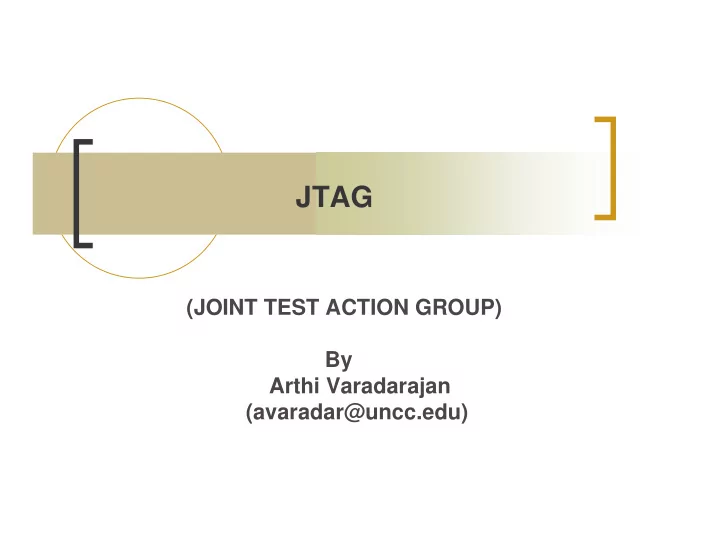

JTAG (JOINT TEST ACTION GROUP) By Arthi Varadarajan (avaradar@uncc.edu)
Topics Discussed …. n BED OF NAILS(BON TESTER) n What is JTAG ??? n Advantages n Boundary Scan logic and Architecture n Real JTAG Applications
BED OF NAILS FIXTURE n PCB Testing was done using Bed of Nails in circuit testing
INCREASED PROBLEM OF TEST
Circuit Complexity
DEVELOPMENT COST
JTAG (1149.1 STANDARD ) IEEE 1149.1, a standard 4 wire serial protocol protocol that established the details of access to any chip with a JTAG port . Boundary scan testing of Integrated Circuits(IC’s) and boards. n Debug Embedded devices. n System level debug capability n
What can it be used for? The standard defines instructions that can be used to perform : Functional Tests n Interconnect tests n Built-in self test procedures. n
Advantages The need for physical test points on the board is eliminated n leading to significant savings as a result of simpler board layouts. Less costly test fixtures. n reduced time on in-circuit test systems. n increased use of standard interfaces. n faster time-to-market. n
Boundary Scan n What is Boundary Scan? Boundary scan is a methodology allowing complete controllability and observability of the boundary pins of a JTAG compatible device via software control.
Boundary Scan Architecture
BOUNDARY SCAN PRINCIPLE How does it work? n The top level schematic of the test logic defined by IEEE Std 1149.1 includes three key blocks: The TAP Controller This responds to the control sequences supplied through the test access port (TAP) and generates the clock and control signals required for correct operation of the other circuit blocks. The Instruction Register This shift register-based circuit is serially loaded with the instruction that selects an operation to be performed. The Data Registers These are a bank of shift register based circuits. The stimuli required by an operation are serially loaded into the data registers selected by the current instruction. Following execution of the operation, results can be shifted out for examination.
JTAG Test Access Port The JTAG Test Access Port (TAP) contains four pins that n drive the circuit blocks and control the operations specified. The TAP facilitates the serial loading and unloading of instructions and data. The four pins of the TAP are: TMS – Test Mode Select n TCK – Test Clock n TDI - Test Data Input n TDO – Test Data Output n
JTAG Test Access Port (Contd) The function of each TAP pin is as follows: TCK - this pin is the JTAG test clock. It sequences n the TAP controller as well as all of the JTAG registers TMS - this pin is the mode input signal to the TAP n Controller. The state of TMS at the rising edge of TCK determines the sequence of states for the TAP controller.
JTAG Test Access Port (Contd) TDI - this pin is the serial data input to all JTAG n instruction and data registers. TDI is sampled into the JTAG registers on the rising edge of TCK. TDO - this pin is the serial data output for all JTAG instruction and n data registers.. TDO changes state on the falling edge of TCK and is only active during the shifting of data through the device. This pin is three-stated at all other times
JTAG TAP Controller The JTAG TAP Controller is a 16-state finite state machine, that controls the scanning of 1. data into the various registers of the JTAG architecture. The state of the TMS pin at the rising edge of TCK is 2. responsible for determining the sequence of state transitions. There are two state transition paths for scanning the signal at 3. TDI in to the device, one for shifting in an instruction to the instruction register ,and , ¡ one for shifting data into the active data register as determined ¡ by the current instruction.
JTAG TAP Controller logic
Data Registers The Device ID register ( IDR ) reads-out an n identification number which is hardwired into the chip. The Bypass register ( BR ) is a 1-cell pass-through n register which connects the TDI to the TDO with a 1-clock delay to give test equipment easy access to another device in the test chain on the same board. The Boundary Scan register ( BSR ), intercepts all n the signals between the core-logic and the pins.
Test Process The standard test process for verifying a device or circuit board using boundary-scan technology is as follows: The tester applies test or diagnostic data on the n input pins of the device. The boundary-scan cells capture the data in the n boundary scan registers monitoring the input pins. Data is scanned out of the device via the TDO pin, n for verification. Data can then be scanned into the device via the n TDI pin. The tester can then verify data on the output pins of n the device.
REAL JTAG APPLICATIONS
References n http://www.ee.ic.ac.uk/pcheung/teachi ng/ee3_DSD/ti_jtag_seminar.pdf n http://www.inaccessnetworks.com/proj ects/ianjtag/jtag-intro/jtag-intro.html n http://toolbox.xilinx.com/docsan/3_1i/d ata/common/jtg/dppa/appa.htm
Recommend
More recommend